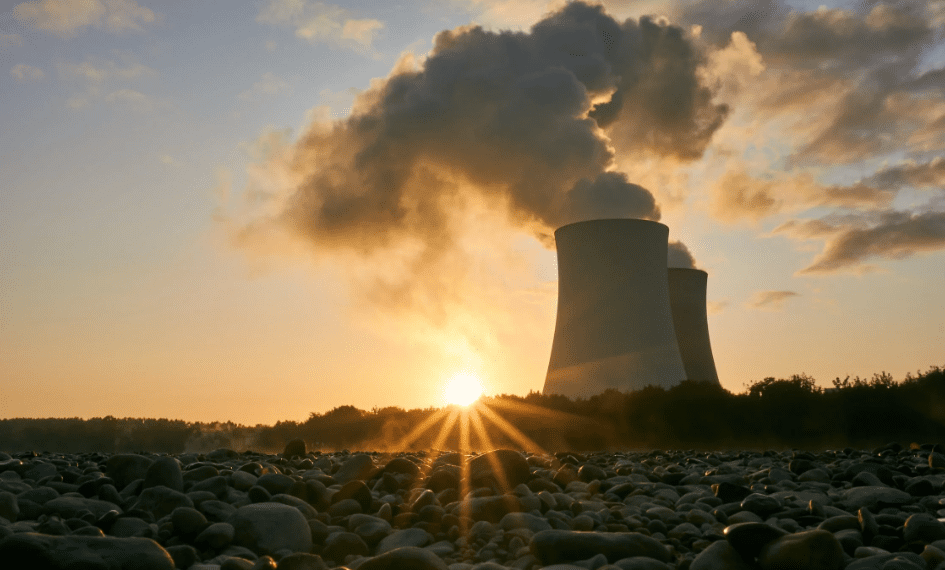When I first thought about investing in nuclear energy, I was quite hesitant. The potential of the technology is incredibly vast; however, it is tainted by past events, and the negative emotions still harbored by people today. Will this technology receive enough backing and traction to become a good investment?
The dawn of the 21st century has been marked by a global shift towards sustainable and efficient energy solutions. Among the diverse options available, nuclear energy emerges as a frontrunner with its potential to mitigate carbon dioxide emissions and combat global warming.
In this post, we will dive into the nuclear energy industry, shedding light on its history, technological advancements, and investment opportunities.
1. Introducing the Nuclear Energy Industry
At its core, nuclear energy is derived from harnessing the enormous power packed within atomic nuclei. The process entails controlled nuclear reactions that release heat, which subsequently generates steam, turning turbines and producing electricity. The vast and intricate nuclear energy industry is mainly segmented into three distinct branches:
- Uranium Mining:
This is the bedrock of the nuclear power industry. Uranium is a naturally occurring radioactive element, and it’s the primary fuel used in nuclear reactors. The process involves extracting and processing uranium ore from the earth to produce yellowcake, a concentrated uranium oxide powder. Companies engaged in this sector have vast operations, often spanning multiple countries, and they ensure a steady supply of uranium to power plants across the globe. - Nuclear Power Generation:
These are the establishments where the magic happens! Nuclear reactors harness the heat generated from nuclear fission – the splitting of an atom – to produce steam which drives turbines and generates electricity. There are currently over 440 operational nuclear reactors worldwide, with several more under construction. - Nuclear Technology and Its Development:
As with any dynamic industry, continuous research, innovation, and technological advancements are paramount. This sector is dedicated to pushing the boundaries of what is possible in nuclear energy. From developing more efficient reactor designs to exploring alternative nuclear fuels and enhancing safety protocols, companies in this sector are the vanguard of nuclear innovation. Their work ensures that nuclear energy remains not just relevant but also increasingly safer and more efficient in the future.
The nuclear industry’s landscape is vast, with a plethora of opportunities spanning across these sectors. The above outline is important to be aware of if you are investing in nuclear energy. According to the World Nuclear Association, the nuclear sector has seen consistent growth, especially in developing nations. With the dual objectives of reducing carbon emissions and ensuring energy security, some countries are turning to nuclear power or warming up to the idea. The stable and cheap energy supply generated from nuclear energy in contrast to many other sources, such as wind and solar, gives this technology a significant edge. This aspect has the potential to ensure the industry’s pivotal role in our energy future.
2. A Brief History: The Evolution of Nuclear Energy
The tale of nuclear energy is a fusion of scientific curiosity, human ambition, and moments of profound impact on civilization. Let us trace back to its origins and pivotal milestones.
- The Scientific Awakening:
The late 19th and early 20th centuries marked an era of groundbreaking discoveries in nuclear physics. In 1896, Henri Becquerel first noticed uranium’s ability to expose photographic film, hinting at its radioactive nature. Following this, the iconic duo Marie and Pierre Curie discovered radium and polonium, laying the foundational understanding of radioactivity. - The E=mc^2 Revelation:
Albert Einstein’s revolutionary equation in 1905 highlighted the relationship between energy (E) and mass (m), suggesting that even tiny amounts of mass could be converted into large amounts of energy. This insight paved the way for the harnessing of energy from atomic reactions. - The Manhattan Project:
World War II accelerated nuclear research but not for power generation. Instead, it was a race to create a weapon of unparalleled destruction – the atomic bomb. The Manhattan Project culminated in 1945 with the detonation of two atomic bombs over Hiroshima and Nagasaki, causing devastation and showcasing nuclear energy’s immense power. - Atoms for Peace:
In the wake of the war, there was a push to harness nuclear energy for constructive purposes. U.S. President Dwight D. Eisenhower’s “Atoms for Peace” speech in 1953 advocated for the peaceful use of atomic energy, especially for electricity generation. - The Rise of Commercial Nuclear Power:
The 1950s and 60s saw the establishment of the world’s first commercial nuclear power plants. With the 1956 opening of the Calder Hall power station in the UK, nuclear energy was no longer just theoretical but a practical source of electricity for thousands. - Setbacks and Lessons:
Despite its promising start, the nuclear energy sector had its share of challenges. Incidents like the Three Mile Island meltdown in 1979, the catastrophic explosion at Chernobyl in 1986, and the Fukushima Daiichi disaster in 2011 highlighted the risks associated with nuclear power. These events, while deeply tragic, were instrumental in driving reforms, enhancing safety standards, and shaping the next generation of nuclear technology.
Today, as we stand at the crossroads of an energy revolution, the history of nuclear energy serves as a reminder of both its unparalleled potential and the responsibilities it bestows upon humanity. Embracing its lessons ensures that as we harness its power, we do so with prudence and a vision for a sustainable future.
If you would like to learn about the history of the stock market, click here.
3. Nuclear Energy: Understanding the Fear and Its Contemporary Significance
The unease surrounding nuclear energy is rooted in genuine concerns, amplified by historical accidents and popular culture portrayals. Fear and taboo can dissuade investors from investing in nuclear energy. But to address the apprehensions of today, it is essential first to understand the sources of these fears.
Historic Catastrophes
As previously mentioned, events like Three Mile Island, Chernobyl, and Fukushima were not just isolated accidents. They became symbolic of the risks of nuclear energy. Especially Chernobyl and Fukushima, which led to large areas becoming uninhabitable and caused significant health issues amongst exposed populations. These incidents showcased the worst-case scenarios of nuclear energy gone wrong and imprinted on the global psyche the dangers of radioactive releases.
Nuclear Warfare
The devastation of Hiroshima and Nagasaki by atomic bombs left a lasting mark on our collective memory. The sheer destructive power of nuclear weapons and the subsequent arms race during the Cold War era added to the anxiety. The association between peaceful nuclear energy and its weaponized counterpart has, at times, been hard for the public to separate.
Radioactive Waste
One of the enduring challenges of nuclear energy is the management of radioactive waste. These materials can remain hazardous for a very long time, some even thousands of years. The fear arises from uncertainties around safe storage solutions and concerns about potential leaks that could contaminate the environment and jeopardize public health.
Cultural Portrayals
Popular culture, especially movies and literature, has often dramatized nuclear disasters. Films like “The China Syndrome” (1979) or series like “Chernobyl” (2019) play a role in shaping public perception, sometimes stressing fears more than the actual risks might warrant.
Contemporary Relevance of These Fears
While the fears have historical roots, they still influence public opinion and policy decisions today:
- Public Perception:
Despite technological advancements, the shadow of past accidents makes many wary of nuclear power plants, especially in or near their communities. - Policy Impacts:
Public apprehension has influenced energy policies worldwide. For instance, after the Fukushima disaster, Germany decided to phase out all its nuclear power plants by 2022. - Hindrance to Growth:
Skepticism can also affect the financing of new nuclear projects, as investors might perceive them as risky, leading to slower adoption rates despite their potential benefits.
However, it is essential to recognize that the nuclear industry has come a long way since these incidents. Modern reactors and safety protocols are designed with the lessons from these events in mind, ensuring that risks are minimized. While it is crucial to respect and understand these fears, it is equally important to assess nuclear energy through the lens of current capabilities and not just past shortcomings.
4. The Renaissance of Nuclear Energy: Pioneering Technological Advancements
While the legacy of nuclear energy is marked with both marvels and missteps, the industry’s present and future has the potential to shine bright thanks to revolutionary technological advancements. Today’s nuclear technology prioritizes safety, efficiency, and environmental responsibility. All of which are important aspects to potential investors who are considering to be investing in nuclear energy.
Gen IV Reactors
The next generation of nuclear reactors, known as Generation IV, are leaps and bounds ahead of their predecessors. Designed with enhanced safety and efficiency in mind, these reactors utilize passive safety systems that require minimal human intervention. In the event of malfunctions, these reactors are equipped to cool down autonomously, significantly reducing the risks of meltdowns. Moreover, many Gen IV designs aim to use nuclear fuel more efficiently, reducing waste output.
Small Modular Reactors (SMRs)
Size matters, especially when it comes to nuclear reactors. SMRs are compact, modular nuclear reactors that can be manufactured off-site and then transported to their desired location. Their small size offers multiple advantages: a reduced initial investment, increased flexibility in deployment, and potential use in remote regions that larger reactors might not feasibly serve. Their modularity means that a facility can incrementally increase its capacity as demand grows.
Thorium-based Reactors
Thorium, an alternative to uranium, presents an intriguing frontier in nuclear energy. Naturally more abundant than uranium, thorium reactors are less weaponizable, addressing proliferation concerns. Moreover, thorium reactors produce waste that is less radioactive in the long-term, potentially easing waste management challenges.
Advancements in Waste Management
Modern nuclear technology is not just about producing energy; it is also about managing the byproducts in a responsible manner. Innovations like deep geological repositories offer solutions for the long-term storage of radioactive waste. Moreover, certain reactor designs under development aim to recycle spent fuel, minimizing waste and making the most out of the initial nuclear material.
Digitalization and Automation
The integration of cutting-edge digital technologies is revolutionizing nuclear power plant operations. Advanced sensors, predictive analytics, and artificial intelligence algorithms are being deployed to monitor reactor health, predict potential issues, and streamline plant operations. This not only enhances safety but also improves operational efficiency.
The Road Ahead
While the strides in nuclear technology are promising, the journey does not end here. The nuclear industry is dynamic, with researchers and scientists continuously pushing the boundaries to unearth even safer, more efficient, and more sustainable nuclear solutions. The convergence of interdisciplinary sciences, from material research to computer science, promises a future where nuclear energy is not only a viable but a leading solution to global energy challenges.
5. Nuclear Energy: A Beacon of Hope in the Battle Against Climate Change
In the face of a rapidly warming planet, the search for scalable, reliable, and clean energy sources has never been regarded as more urgent by governments in the western part of the world. Nuclear energy holds unparalleled potential as a solution to our pressing environmental challenges. By investing in nuclear energy you are actively contributing to enable this technology in the world.
Carbon-Free Energy Production
Unlike fossil fuel-based power plants, nuclear reactors do not emit carbon dioxide during operation. According to the World Nuclear Association, nuclear power prevents the emission of about 2.5 billion tons of CO2 annually, equivalent to taking over 500 million cars off the road each year. This zero-emission profile makes nuclear energy a powerful tool in our arsenal against global warming.
Consistency and Reliability
Renewable energy sources like solar and wind are commendable for their sustainability. However, their intermittent nature, dependent on sunlight or wind availability, can pose challenges. Nuclear power plants operate reliably, providing consistent “baseload” power regardless of weather conditions or time of day. This reliability ensures that energy grids can maintain supply even when renewables might not be producing at capacity.
Land and Resource Efficiency
Nuclear energy is incredibly dense. A small pellet of uranium fuel can release as much energy as a ton of coal. This energy density means that nuclear power plants, while substantial in structure, occupy far less land than, say, solar farms or wind parks of equivalent output. This efficient land use minimizes habitat disruption and conserves natural landscapes.
Supporting the Renewable Revolution
Nuclear energy can act as a complementary force alongside renewables. Advanced reactor designs, like some Small Modular Reactors (SMRs), can adjust their output based on demand, making them ideal partners for renewable sources. As renewables ramp up production during sunny or windy periods, nuclear can scale back, ensuring a balanced and consistent energy supply.
Strategic Role in a Holistic Energy Portfolio
No single energy source can shoulder the responsibility of powering our future sustainably. A balanced energy portfolio, leveraging the strengths of various sources, is our best bet. Nuclear energy’s role in this mix is to provide consistent, large-scale, and carbon-free power, serving as the backbone that other renewable sources can supplement.
The Environmental Imperative
While nuclear energy is not without its challenges, its potential benefits in the fight against global warming are undeniable. As technological advancements continue to make it safer and more efficient, nuclear energy’s role in crafting a sustainable, low-carbon future becomes even more significant.
6. Investing in Nuclear Energy
The nuclear energy sector, rejuvenated by technological advancements and an escalating need for carbon-free power, offers intriguing investment opportunities. But as with all investments, it is essential for us to be able to navigate our investment opportunities with an informed perspective.
Understanding the Market Landscape
The nuclear industry is not monolithic. It spans a range of segments that are important to be aware of when investing in nuclear energy as a sector:
- Uranium Mining:
This is the starting point of the nuclear fuel cycle. Companies in this segment focus on the extraction of uranium ore, a key raw material for nuclear reactors. Companies like Cameco (NYSE:CCJ) and Kazatomprom (LSE:KAP) are significant players. - Reactor Manufacturers:
These enterprises design and build the nuclear reactors that produce electricity. General Electric (NYSE:GE), through its joint venture GE Hitachi Nuclear Energy, is a notable player. Westinghouse Electric Company, while a major manufacturer, is privately held. - Utilities:
Companies in this sector own and operate nuclear power plants, generating and selling electricity to consumers. EDF (EDF on Euronext Paris) in France and NextEra Energy (NYSE:NEE) in the US are examples of utilities with nuclear assets. - Nuclear Services & Waste Management:
This segment encompasses firms that provide maintenance services to operating reactors and manage radioactive waste. Orano, formerly known as Areva, is a prominent name, though it is state-owned and not publicly traded. - Growth Projections:
According to the World Nuclear Association, over 50 reactors are under construction worldwide, indicating growth in the sector. The rise of Small Modular Reactors (SMRs) and advancements in reactor technology suggest a bright future for reactor manufacturers. Uranium demand is also poised to grow as more reactors come online.
Factors to Consider
Investing in nuclear energy comes with its unique set of considerations:
- Regulatory Environment:
Nuclear energy is heavily regulated. A country’s stance on nuclear energy can significantly impact businesses in this sector. - Technological Advancements:
Keep an eye on emerging nuclear technologies, as they can disrupt the status quo and offer significant growth potential. - Public Perception:
The acceptance of nuclear energy by the public can influence policy decisions, thereby affecting industry prospects. - Global Energy Dynamics:
The broader energy market, including the rise of renewables or global energy demand shifts, can shape nuclear energy’s trajectory. - Research & Diversification:
As with all investments, thorough research is paramount. Utilize a mix of sources, including company annual reports, industry publications, and independent analyses. Additionally, diversifying your investments across different segments of the nuclear industry can help spread and manage risks. - Your Nuclear Investment Journey:
While there are incredible opportunities, the inherent complexities of the sector demand a well-informed, strategic approach. By understanding the nuances and staying updated with industry developments, investors can position themselves to harness the potential of this prominent energy frontier.
Always ensure that your investments align with your investment strategy.
In Conclusion
As the global demand for clean energy intensifies, nuclear energy stands tall as a potent solution. With its significant role in a carbon-neutral future and technological advancements making it safer than ever, the nuclear industry beckons forward-thinking investors. Whether you should be investing in nuclear energy can be a tough decision. However, being a reliable, clean, safe, stable, cheap, and carbon-neutral option, the nuclear energy technology is radiating future potential for our energy sector.





